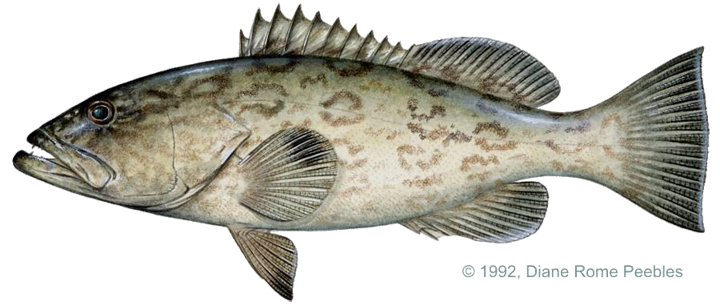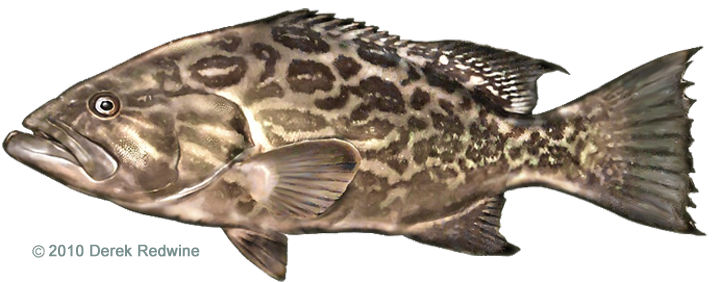Game Fish Identification Reference Guides
Grouper, gag
(Mycteroperca microlepis)
(Mycteroperca microlepis)

(Goode & Bean 1879); SERRANIDAE FAMILY; also called black grouper, charcoal belly, cuna aguají, badèche baillou, badejo-da-areia
The distribution of gag grouper extends in the western Atlantic from North Carolina, USA (with juveniles occurring as far north as Massachusetts) to the Yucatan Peninsula, Mexico; it is rare in Bermuda and absent from the Caribbean and Bahamas. Gags are the most common grouper on rocky ledges in the eastern Gulf of Mexico. Juvenile gags reside in estuaries and seagrass beds while adults are usually found offshore on hard substrate in water 60 – 250 feet deep (rarely to 152 m) and occasionally inshore on rocky or grassy bottom. Adults are either solitary or found in groups of 5 to 50 individuals.
The coloration is extremely variable but generally brownish gray overall with a pattern of dark, worm-like or kiss-shaped markings along the sides. Gags can be distinguished from black grouper, Mycteroperca bonaci, that often occur in the same habitat by the distinctive color pattern and the shape of the preopercle. The gag has a noticeably notched preopercle (the middle bone of the gill cover) with a distinct lobed appearance while black grouper have an evenly rounded preopercle with no definite lobe below.
Bottom fishing is the most effective method of catching gag. Anglers commonly use depth recorders to locate rocky outcrops and irregular bottom where gags congregate, anchoring when a likely area is located. Wrecks and oil rigs in shallow shelf waters of the Gulf also attract many gags. They are an excellent light-tackle target for those fishing relatively shallow waters and the white flaky flesh of gags makes it excellent eating.
Spawning aggregations of gags in the Middle Grounds of the Gulf of Mexico from January through March. Young gags are predominantly female, transforming into males, as they grow larger
The distribution of gag grouper extends in the western Atlantic from North Carolina, USA (with juveniles occurring as far north as Massachusetts) to the Yucatan Peninsula, Mexico; it is rare in Bermuda and absent from the Caribbean and Bahamas. Gags are the most common grouper on rocky ledges in the eastern Gulf of Mexico. Juvenile gags reside in estuaries and seagrass beds while adults are usually found offshore on hard substrate in water 60 – 250 feet deep (rarely to 152 m) and occasionally inshore on rocky or grassy bottom. Adults are either solitary or found in groups of 5 to 50 individuals.
The coloration is extremely variable but generally brownish gray overall with a pattern of dark, worm-like or kiss-shaped markings along the sides. Gags can be distinguished from black grouper, Mycteroperca bonaci, that often occur in the same habitat by the distinctive color pattern and the shape of the preopercle. The gag has a noticeably notched preopercle (the middle bone of the gill cover) with a distinct lobed appearance while black grouper have an evenly rounded preopercle with no definite lobe below.
Bottom fishing is the most effective method of catching gag. Anglers commonly use depth recorders to locate rocky outcrops and irregular bottom where gags congregate, anchoring when a likely area is located. Wrecks and oil rigs in shallow shelf waters of the Gulf also attract many gags. They are an excellent light-tackle target for those fishing relatively shallow waters and the white flaky flesh of gags makes it excellent eating.
Spawning aggregations of gags in the Middle Grounds of the Gulf of Mexico from January through March. Young gags are predominantly female, transforming into males, as they grow larger














